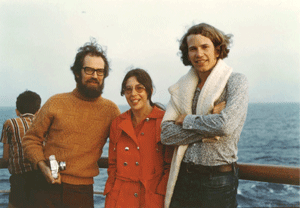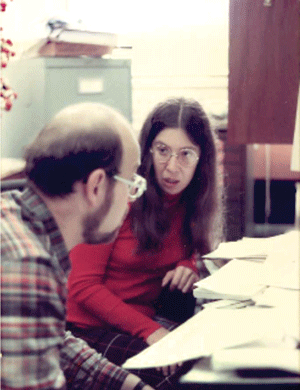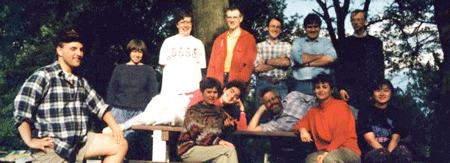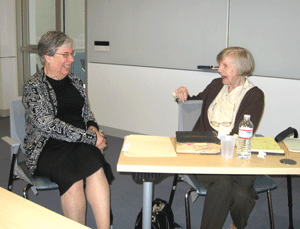Memoir - Helen M. BermanMemoir | Publications | Curriculum Vitae | Videos | Slides | Interviews | Articles | Obituary ACA Living History2012
I was born in Chicago and raised in Brooklyn, NY. My father was a physician, and my mother was a housewife who also acted as his office assistant for his medical practice. From as early as I can remember, I was strongly encouraged to pursue a medical career. Growing up, I attended New York City public schools and was always a very good student. After my junior year in high school, I was fortunate enough to be able to be in an NSF-sponsored program run by Moses Tendler at Yeshiva University. In that program, high school students took classes in the morning and were then assigned to research labs in New York City. I went to work in Ingrith Deyrup's laboratory at Barnard College. Ingrith, a biology professor, was studying active transport in kidneys. As part of my work in her lab, I had to learn how to work with animals from mice and rats to groundhogs. I coaxed the animals out of their cages that were on a roof of a college building on Broadway. After anesthetizing the animals, I removed their kidneys and performed further experiments under the direction of very kind and competent graduate students. It was quite an introduction to biology. Largely at Ingrith's urging, I applied to Barnard College and was accepted. Barnard was a small women's college associated with Columbia University, and turned out to be the perfect school for me to attend. At Barnard I decided to major in chemistry. At the end of my second year, my physics professor Daniel Greenberg arranged for me to work in Barbara Low's (b. 1920) laboratory at Columbia College of Physicians and Surgeons. So in 1962 at the age of 19, I had my first experience working with crystals and I loved it. Every day I went into the cold room, selected a crystal that had been soaked in heavy atom solution, mounted it in a capillary, and took pictures on a precession camera. Barbara gave the undergraduates tutorials every week. Through these experiences, we learned about symmetry and diffraction and reciprocal space. By the end of the summer I knew that I wanted to be a crystallographer.
Helen and members of the Pittsburgh lab at a lab picnic in 1965 When I graduated in 1964 I decided to pursue my graduate training at the University of Pittsburgh with George Allen "Jeff" Jeffrey. This meant of course that I had to leave my beloved New York to go to the wild, Wild West (Yes, The New Yorker cover cartoon, in March 1976, by Daniel K. Wallingford is completely accurate.) As per Jeff's advice, I took the minimum number of courses and began research very early on. Bryan Craven, Bob Rosenstein, Dick McMullan, Martin Sax and Ryonosuke Shiono trained the students in formal and informal settings. My research project involved determining the structures of carbohydrates, some of which were very challenging and provided a perfect test bed for the newly emerging direct methods. Many of the authors of these programs visited Pitt and I got a chance to use these programs and learn from the masters including Peter Main, Paul Beurskens and Syd Hall. I also became enamored of computing and how it was essential for our science. The students in my era also contributed to the Pitt experience. Sundaralingam directly preceded me, as did Sung-Hou Kim. Ned Seeman and George de Titta arrived just as I was finishing my degree. The experience at Pitt was intense and challenging. In addition to crystallography, Jeff was very interested in structure classification and comparison. It is clear to me now that this had a huge influence on my thinking.
Ned Seeman, Joel Sussman, Helen Berman, and Sung-Hou Kim in front of MIT. In 1966 Sung Hou had moved on to Boston for his post doc at MIT, and through him I met the students of Cy Levinthal including Joel Sussman. I became fascinated by the world of protein folding. As part of my Ph.D. qualifier, I had to create a hypothetical grant proposal. Strongly influenced by the work I had seen at MIT, I proposed to perform structure-based sequence comparisons of known proteins, make model peptides of conserved regions, and then determine the crystal structures to see if the fragments kept these structural features. Of course, this work would require access to protein structure coordinates—not something easily available at the time. Once I completed my Ph.D. and post doc at Pitt, I went to work in Jenny Glusker's laboratory at the Institute for Cancer Research (ICR) in Philadelphia. During that period I worked with Joel Sussman, Sung-Hou Kim and Ned Seeman on the structure of a dinucleoside UpA (Seeman et al., 1971). Since we worked in different cities and it was the 1970's, we referred to ourselves as the "East Coast Conspiracy". In that same time, I became very involved in trying to set up a repository for protein structures. Among the activists in this effort were Edgar Meyer and Gerson Cohen. We wrote letters to people and even had a petition sent to the ACA asking for support. In 1971, I went to the meeting on Structure and Function of Proteins at the Three Dimensional Level at Cold Spring Harbor Laboratory and further discussed the idea of a protein data resource. Protein crystallographers had already been talking about how to set up an archive and Walter Hamilton (Brookhaven National Laboratory) readily agreed to take on this project, especially since Edgar was working on a protein library at BNL. After forming an agreement with Olga Kennard at the Cambridge Crystallographic Data Centre, the Protein Data Bank was formally announced (Protein Data Bank, 1971). In 1973 after Walter's death, Tom Koetzle took over the leadership of that project. My involvement was advisory in nature; I was content that the PDB existed.
Walter Hamilton, Helen, and Tom Koetzle on the way to a meeting in Aarhus in 1972. At ICR, I had a small research group who worked on drug nucleic acid fragments and the systematics of nucleic acid structure in collaboration with Stephen Neidle in London. I also became involved in setting up the research computing facilities for what was now the Fox Chase Cancer Center (FCCC).
Stephen Neidle and Helen in his office at King's College London in the late 1970s. In 1979 my son Jason was born. Several of the female faculty began to discover the challenges of raising a family and maintaining a productive career, and we encouraged the establishment of a day care center at FCCC. All was wonderful and well until I was diagnosed with breast cancer in 1982 and again in 1986. In the midst of treatment I had to put together the abstract book for an ACA meeting, and thanks to Judy Flippen-Anderson we managed to meet all the deadlines. The experience of having cancer and working in a cancer center was very challenging and in 1988 I decided that I needed a new venue. In July 1989, I moved to Rutgers University as a Professor of Chemistry.
All my interests came together at Rutgers: crystallography, computers, nucleic acids, proteins, systematics. And I had the added bonus of being able to transfer knowledge to new generations of students. On the nucleic acid front, we continued to study structures of fragments and with Bohdan Schneider did a study of the hydration patterns around nucleic acids. We discovered that the patterns are local and predictable for the bases (Schneider & Berman, 1995). With Wilma Olson, we established the Nucleic Acid Database as a repository for nucleic acids (Berman et al., 1992). The idea of that project was to create a home for nucleic acid structures of all sizes, which meant combining structures from the PDB and the CCDC. The NDB became a test bed for creating a searchable relational database. I became involved in creating the mmCIF dictionary working with Paula Fitzgerald, Phil Bourne and John Westbrook and used that formalism as the underlying structure of the NDB (Fitzgerald et al., 2005). By assuring me that collagen and nucleic acids had much in common, Barbara Brodsky, a professor at the medical school, convinced me to work on collagen. Together with Jordi Bella, we solved the structure of a model peptide of collagen and using the same methods Bohdan had developed for nucleic acid hydration, we discovered predictable water patterns in collagen (Bella et al., 1994; Bella et al., 1995). One of the great pleasures of all this work was the participation of very bright undergraduate students. It was wonderful to work with them in the same way that my early mentors worked with me.
IUCr mmCIF meeting in Brussels with John Westbrook, Phil Bourne, Paula Fitzgerald, Sydney Hall, and Shoshana Wodak (1994). Meanwhile, the Protein Data Bank continued to grow at BNL. Joel Sussman became the lead in 1993 and for a time we worked together on the challenges involved in supporting the infrastructure required to manage these data. When the NSF issued a call for proposals in 1998, I decided that it was time to step forward and try to create a new-generation PDB. I formed the RCSB consortium with Phil Bourne at the San Diego Supercomputer Center at the University of California San Diego and Gary Gilliland at the National Institute of Standards and Technology. We were funded to manage the PDB and its approximately 9000 structures (Berman et al., 2000). Somehow, we got through the transition and were able to keep the resource going without any breaks in service. We learned to build the resource systematically and met the challenges of a production environment in which there is an expectation of 24/7 services. In 2003, we joined forces with PDBe headed by Kim Henrick and PDBj headed by Haruki Nakamura to form the Worldwide Protein Data Bank (wwPDB), thus ensuring that the PDB would remain a single, uniform and global service (Berman et al., 2003). And in 2011, with more than 80,000 structures in the archive, a symposium was held in Cold Spring Harbor commemorating the 40thanniversary of the PDB (Berman et al., 2012).
Helen and Barbara Low (b. 1920), Professor Emeritus of Biochemistry and Biophysics at Columbia University, who gave an invited lecture on penicillin to Helen's undergraduate honors class at Rutgers in spring 2012. I feel very lucky that the dreams and aspirations I had as a young woman have come to fruition and that I have the privilege of continuing to do productive work. My son is now grown and a physicist. I discovered that I have the BRCA 1 mutation and yet have somehow survived. My dream is that in my lifetime we can understand biology and medicine at the molecular level so that it will be possible to circumvent the errors of our genes. References Bella, J., Brodsky, B. & Berman, H. M. (1995). Structure 3, 893-906. Bella, J., Eaton, M., Brodsky, B. & Berman, H. M. (1994). Science 266, 75-81. Berman, H. M., Henrick, K. & Nakamura, H. (2003). Nat Struct Biol 10, 980. Berman, H. M., Kleywegt, G. J., Nakamura, H. & Markley, J. L. (2012). Structure 20, 391-396. Berman, H. M., Olson, W. K., Beveridge, D. L., Westbrook, J. D., Gelbin, A., Demeny, T., Hsieh, S.-h., Srinivasan, A. R. & Schneider, B. (1992). Biophys. J. 63, 751-759. Berman, H. M., Westbrook, J. D., Feng, Z., Gilliland, G., Bhat, T. N., Weissig, H., Shindyalov, I. N. & Bourne, P. E. (2000). Nucleic Acids Research 28, 235-242. Fitzgerald, P. M. D., Westbrook, J. D., Bourne, P. E., McMahon, B., Watenpaugh, K. D. & Berman, H. M. (2005).Vol.G. Definition and exchange of crystallographic data, International Tables for Crystallography, edited by S. R. Hall & B. McMahon, pp. 295-443. Dordrecht, The Netherlands: Springer. Protein Data Bank (1971). Nature New Biology 233, 223. Schneider, B. & Berman, H. M. (1995). Biophys. J. 69, 2661-2669. Seeman, N. C., Sussman, J. L., Berman, H. M. & Kim, S.-H. (1971). Nature New Biology 233, 90-92. |








